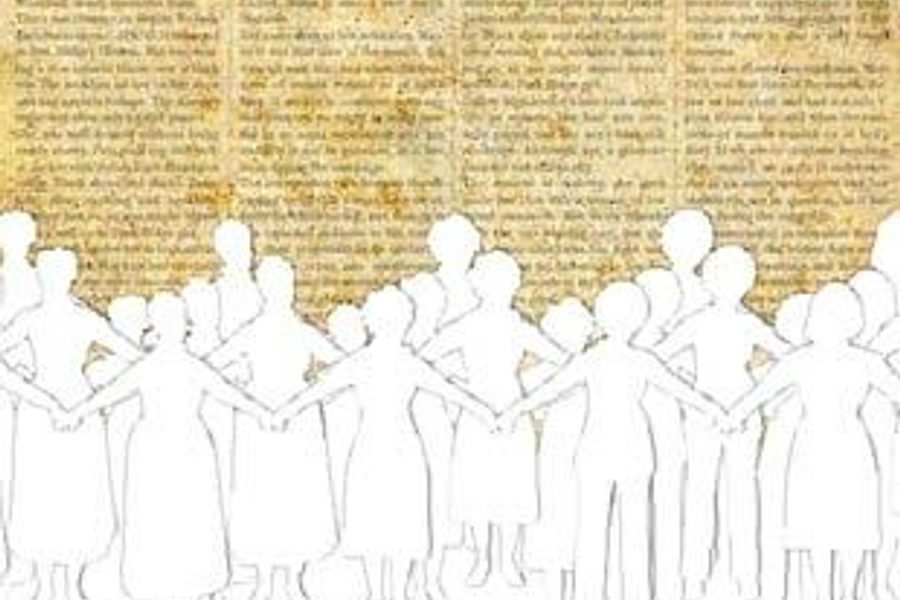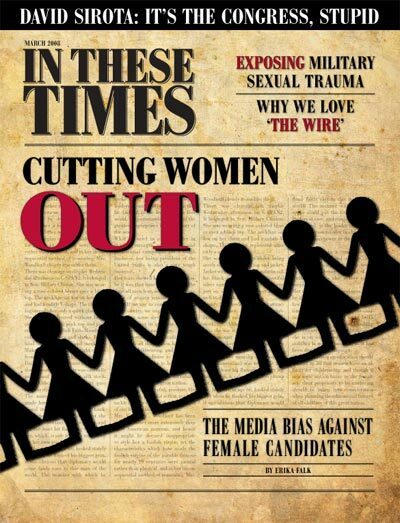
Victoria Woodhull wore “dainty high-heeled boots,” observed the New York Times in an 1872 editorial on the Equal Rights Party candidate for president. In that editorial, titled “A Lamp Without Oil,” the Times had this to say about the successful stockbroker and women’s rights activist:
Mrs. Victoria C. Woodhull has been married rather more extensively than most American matrons, and hence it might be deemed inappropriate to style her a foolish virgin; yet the characteristics which have made the foolish virgins of the parable famous for nearly 19 centuries were mental rather than physical, and in her inconsequential method of reasoning. Mrs. Woodhull closely resembles them.
More than 130 years later, the Washington Post, in an article about presidential candidate Sen. Hillary Clinton (D-N.Y.), reported, “There was cleavage on display Wednesday afternoon on C-SPAN2. It belonged to Sen. Hillary Clinton.” Although Clinton was talking about education policy, reporter Robin Givhan noted, “She was wearing a rose-colored blazer over a black top. The neckline sat low on her chest and had a subtle V-shape. The cleavage registered after only a quick glance. No scrunch-faced scrutiny was necessary. There wasn’t an unseemly amount of cleavage showing, but there it was. Undeniable.”
Despite striking advances over the last century in women’s social and political rights, and in attitudes about women in politics, press coverage of women candidates is not much better today than it was in 1872. The most significant consequence of this is not that, should a woman run, the press would make it less likely for her to win. Rather, the real problem is that such press coverage may make women less likely to run.
Though the mainstream media tend to frame women who run for president as novelties, they are not. Women have led nations such as Canada, France and the United Kingdom, not to mention Turkey, Pakistan, Sri Lanka and many others. In fact, there have been so many historical and contemporary women heads of state that one has to scroll through pages to get a complete list.
Here at home, women have been running for the presidency since before universal suffrage, as Woodhull’s candidacy demonstrates.
In his comprehensive list of people who have run for president, James Havel, author of U.S. Presidential Candidates and the Elections: A Biographical and Historical Guide, included more than 100 women’s names. Some of these women were serious candidates, qualified for federal primary matching funds, and even received substantial press coverage. Here are a few:
Woodhull ran as the Equal Rights Party candidate in 1872. She owned her own newspaper, was the first woman stockbroker on Wall Street, and presided over and supported her extended family.
The second woman to run for president was Belva Lockwood in 1884. As an attorney and partner in her own firm, and as the first woman to practice law before the U.S. Supreme Court, she had a profession consistent with those of other presidential candidates. Lockwood had also campaigned for presidential candidate Horace Greeley, and drafted a piece of legislation making it illegal to take into account a person’s sex in determining pay for civil servants. Congress later passed the bill.
Former Sen. Margaret Chase Smith (R-Maine) sought the presidential nomination of the Republican Party and was the first woman already holding federal office to run. She ran in 1964 after serving nine years in the House and 15 years in the Senate. Smith placed third in popular votes in the Republican primary, but she received only 27 delegate votes at the convention that ultimately nominated Barry Goldwater.
In 1988, former Rep. Patricia Schroeder (D-Colo.), a Harvard-educated attorney who had served in Congress for eight terms, ran for president. At the time, she was a senior member of the House Armed Services Committee.
Twelve years later, Elizabeth Dole sought the Republican nomination. Also a Harvard-educated lawyer, Dole had served in the cabinet of two different presidential administrations (as secretary of transportation and secretary of labor) and had executive experience as president of the American Red Cross. She is currently a U.S. senator from North Carolina.
In 2004, former Sen. Carol Moseley Braun (D-Ill.) ran for president, making her the most recent woman to seek the nomination until Clinton’s 2007 declaration. A Chicago native, Moseley Braun had served six years as an assistant U.S. attorney, 10 years in the Illinois House of Representatives and one term as U.S. senator. She was the ambassador to New Zealand during President Clinton’s administration.
When comparing the press coverage of eight women who sought the Oval Office between 1872 and 2004 – Woodhull, Lockwood, Chase Smith, Shirley Chisholm, Lenora Fulani, Schroeder, Dole and Moseley Braun – with the coverage of eight men who ran in their respective races and had similar experience – James Black, Benjamin Butler, Nelson Rockefeller, Henry Jackson, Ron Paul, Richard Gephardt, Steve Forbes and Bob Graham – it’s clear women who have run for the Oval Office have not been treated fairly by the press. In fact, this trend became evident after looking at each campaign and the newspaper coverage in each candidate’s home state, as well as looking at the top six circulating newspapers in the United States (USA Today, Wall Street Journal, New York Times, Los Angeles Times, Denver Post and Chicago Tribune).
Because data from Clinton’s campaign is still too new, much of the information draws on earlier women candidates.
Less coverage, less substance
Based on these eight races, women candidates for president consistently received less press coverage than equivalent men running in the same race. On average, the men candidates earned twice as many articles as the women, and the articles about the men were 7 percent longer.
The available data for the Clinton/Barack Obama (D-Ill.) race was on par with this pattern. In January 2007 – the first month of Clinton’s and Obama’s candidacies – the six U.S. newspapers with the highest circulation ran 59 stories that mentioned Obama in the headline and just 36 that mentioned Clinton.
In addition to giving women less overall coverage, the press gave women candidates less substantive coverage. In the eight races, men were likely to have more issues covered than the women.
The average apportionment of paragraphs dedicated to the issues was 16 percent for the women and 27 percent for the men. In other words, the men had 68 percent more paragraphs written about issues than did the women.
In the first month of her campaign, Clinton did better than most women who preceded her: 22 percent of her paragraphs were about issues. However, that still falls short of the average amount of policy coverage afforded male candidates.
Doting on appearance
Not only does the press skimp on important issue coverage, it is also more likely to include extraneous information. Coverage of how women candidates look – while ignoring such observations about men candidates – has been an ongoing problem of mainstream political reporting.
Physical descriptions have included such irrelevancies as the New York Sun’s description that Woodhull’s “hair was carefully parted,” or that she wore “blue silk stockings.” They also included the Bangor Daily News’ observation that Chase Smith was “not a glamour puss” and the Colorado Rocky Mountain News’ report that Schroeder was “attractive.”
Each of the eight women received about four physical descriptions for every one that described a man. And between 1872 and 2004, a substantial change in the media’s pattern did not occur. In fact, the newspapers described Democratic candidate Moseley Braun physically more often in 2004 than did the newspapers from Woodhull’s race in 1872. In 2000, newspapers described Dole’s physical appearance as often as papers described Chase Smith’s in 1964.
The press included physical descriptions of men in just 14 percent of articles about them. For women, it was a whopping 40 percent.
Clinton did better on this front than women who preceded her, but still the media did not treat her in a way that was similar to a typical male candidate. About 29 percent of stories about Clinton contained a physical description.
Though most physical descriptions of Clinton focused on the fact that she was a woman – as in, “female presidential candidate” – her attire still made it into the press.
The Chicago Tribune described her this way: “Clinton was well-dressed without being overly showy. Pale pink top and jacket. Jacket with stylish Euro-Mandarin collar. Black shoes and slacks. Beautiful silver earning and necklace. Makeup just so, as one might expect from a well-to-do Park Ridge girl.”
When men were described, they were likely to be described by their age and facial expressions. For example, Steve Forbes was regularly described as a “51-year-old” and Bob Graham as “66.” Nelson Rockefeller “flashed his biggest grin.”
Traditionally, women’s appearance has been assumed to be a primary measure of a woman’s value, especially in regard to her ability to find a good husband. Though few in contemporary American society would publicly agree with this, the persistence with which the press has commented on the physical aspect of women candidates perpetuates this value system’s ideology and legacy.
One concern is that women may be less likely to run if they feel their appearance will become the subject of public dialogue. And voters may conclude that candidates with more physical descriptions should not be taken seriously. Perhaps more coverage of appearance reinforces the prejudiced view that women are first and foremost objects, whereas men are actors.
Chronicling emotions
Historically, the press has also reported on women’s emotions more than those of men. Again, in the eight races, women received twice as many emotional descriptions as did the men. Given this, it is not surprising the media is obsessed over Clinton’s passionate reply on Jan. 7, 2008, in Portsmouth, N.H., to a question about the challenges of campaigning.
What was surprising, however, was that much of the mainstream press focused on the possible benefit Clinton may have derived from showing the depth of her motivation. This is at odds with traditional coverage. Typically the media focus on emotion in women as a sign of their unsuitability for office.
But this was not entirely absent from the contemporary discourse either.
Former Sen. John Edwards’ widely quoted response to Clinton’s Portsmouth moment was indicative of the way women’s emotionality has been negatively viewed. When asked for his response to Clinton’s display of emotion, Edwards said, “I think what we need in a commander in chief is strength and resolve, and presidential campaigns are a tough business, but being president of the United States is also a very tough business.”
The idea that women are too emotional for leadership is part of the stereotype that women have a biological drive toward nurturing and child-raising that makes them emotional and irrational, rendering them incapable of logic and reason – and therefore incapable of leading and legislating.
Going forward
Although it is easy to get demoralized by these findings, we must keep in mind that studies of non-presidential races show that when women run for political office, they win just as often as men do – despite media bias.
In 1997, three researchers – Richard Seltzer, a professor of political science at Howard University, Jody Newman, former executive director of the National Women’s Political Caucus (NWPC) and Melissa Voorhees Leighton, former membership director at NWPC – conducted a study in which they compared two things. First, the actual success rates of men and women who were candidates in general elections for state legislatures in 1986, 1988, 1990, 1992 and 1994. And second, the success rates for men and women running for the U.S. House, U.S. Senate and governor from 1972 to 1994.
They found “no differences between success rates for men and women in the general election.” This suggests that women are perfectly capable of overcoming bias in the press, and these findings should not deter women from running.
For female candidates aspiring to run for elected office, a media strategy plan that compensates for bias is essential.
First, to overcome the press’s tendency to ignore their policy positions, women should run campaigns that emphasize issues.
Second, candidates should project an image of rationality and minimize emotional expressions to overcome the press’s heightened attention to this.
Third, women candidates and their supporters should monitor the media and be vocal against coverage that is sexist, unfair or biased.
And finally, women should frame their candidacies as normal, natural and common in order to overcome the mainstream press’s propensity to portray them as unusual.
We should not tolerate press bias just because women can overcome it. The idea that the media systematically – even if unconsciously – put a class of people at a disadvantage strikes at the very heart of our assumptions about our democracy.
America prides itself on being the freest, most equal society in the world. But for that to be true, people must have equal access to power. A press that does not give equal measure to men and women suggests a fissure in that ideal.






